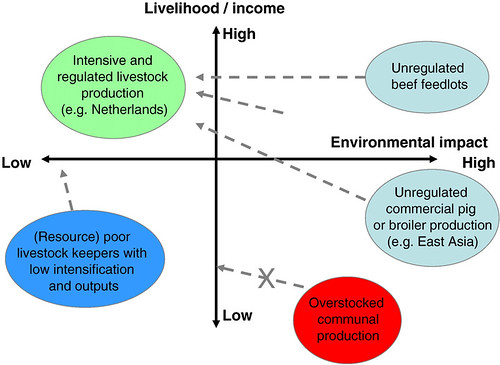Graphic showing pathways of livestock systems evolution to increase the sustainability of livestock production in selected systems, published in a paper by John McDermott et al, ‘Sustaining intensification of smallholder livestock systems in the tropics, Livestock Science (2010) (illustration credit: ILRI/McDermott).
John McDermott, who serves as deputy director general-research at the International Livestock Research Institute (ILRI), and some of his ILRI colleagues published a paper in Livestock Science that sets out what will be needed to make livestock production a sustainable system for smallholders in the developing world, enhancing both the livelihoods and environmental resources of the poor. The abstract of this ILRI paper follows.
‘Smallholder livestock keepers represent almost 20% of the world population and steward most of the agricultural land in the tropics. Observed and expected increases in future demand for livestock products in developing countries provide unique opportunities for improving livelihoods and linked to that, improving stewardship of the environment.
‘This cannot be a passive process and needs to be supported by enabling policies and pro-poor investments in institutional capacities and technologies. Sustaining intensification of smallholder livestock systems must take into account both social and environmental welfare and be targeted to sectors and areas of most probable positive social welfare returns and where natural resource conditions allow for intensification.
‘Smallholders are competitive in ruminant systems, particularly dairy, because of the availability of family labour and the ability of ruminants to exploit lower quality available roughage. Smallholders compete well in local markets which are important in agriculturally-based or transforming developing countries.
‘However, as production and marketing systems evolve, support to smallholders to provide efficient input services, links to output markets and risk mitigation measures will be important if they are to provide higher value products. Innovative public support and links to the private sector will be required for the poor to adapt and benefit as systems evolve. Likewise targeting is critical to choosing which systems with livestock can be intensified. Some intensive river basin systems have little scope for intensification. More extensive rain-fed systems, particularly in Africa, could intensify with enabling policies and appropriate investments. In more fragile environments, de-intensification is required to avoid irreversible damage to ecosystems.
‘Attention to both social and environmental sustainability are critical to understanding tradeoffs and incentives and to bridging important gaps in the perspectives on livestock production between rich and poor countries and peoples. Two specific examples in which important elements of sustainable intensification can be illustrated, smallholder dairy systems in East Africa and South Asia and small ruminant meat systems in Sub-Saharan Africa, are discussed.’
Read the whole paper, J.J. McDermott, S.J. Staal, H.A. Freeman, M. Herrero and J.A. Van de Steeg, Sustaining intensification of smallholder livestock systems in the tropics, published in Livestock Science, 2010: doi:10.1016/j.livsci.2010.02.014


Pingback: Pathways of the evolution of livestock production systems « ILRI news | Poultry and Feeds